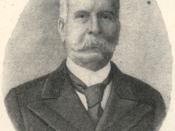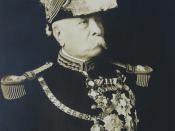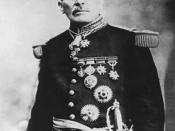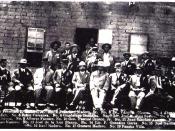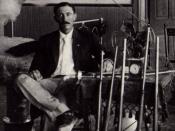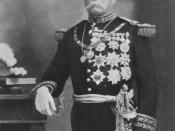The Mexican Revolution World History 3, period 5 June 6, 2000 There was a huge revolution in the country of Mexico that started in the year 1910, led by Porfirio Diaz, the president of Mexico in 1910. In the 1860's Diaz was important to Mexican politics and then was elected president in 1877. Diaz said that he would only be president for one year and then would resign, but after four years he was re-elected as the President of Mexico. Porfirio Diaz and the Mexican revolution had a huge impact on the country of Mexico that is still felt in some places today.
The earliest start to the Mexican Revolution of 1910 happened one hundred years earlier when two priests, Miguel Hidalgo and Jose Morelos, led a stand against the Spanish colonial officials who were controlling Mexico at the time. On September, 16 1810 Hidalgo led Mexico's Indians in a revolution directed against the Spanish plantation owners in northern Mexico.
He was motivated by a need for a new government and a re-location of both the church's and plantation owner's lands. Hidalgo and the Indians, armed with only farm tools and weapons, marched towards Mexico City. While Hidalgo was marching into Mexico City, Jose Morelos organized an attack force and began raiding Spanish plantations and towns. Hidalgo's army was defeated in 1811 and he was executed. Jose Morelos took control of the revolution and led attacks until the Spaniards captured and killed him in 1815. When Morelos died so did the revolution of 1810.( www.tamu.edu/ccbn/dewitt/mexicanrev.htm, Encarta 98) In 1876, Porfirio Diaz, an Indian general in the Mexican Army took control of the nation, and continued to be elected until 1910. This new era was too one way and started the Mexican Revolution. The government eventually allowed Mexico to fall into dictatorship that gave way to a new a powerful upper class. When Diaz came into power he had high hopes for Mexico's future, and established a stable government that rid the nation of crime. The quality of life improved around the towns and the cities.. The way the government worked was expanded when Diaz sent out his strong governors to rural areas. The military was made stronger by using more professional methods of training the soldiers. From this way of training came a military police force called the Rurales made of thousands of troops. This police force kept order and enforced Diazs' laws. Diaz also counted on the Cientificos, a group of commanding people who acted as advisors. The Cientifico's way was one of French positivism. Diaz used this philosophy to make reasons for his policies. Diaz kept his old slogan "liberty, order, progress", but, the word liberty was removed from the slogan. Another slogan "few politics, much administration" also became common and popular. Foreign firms began to invest in Mexico because it became more structurally and economically stable. These investments gave Diaz the money he needed to construct highways, railroads, telegraph lines, and new industries. The city of Veracruz used the money to create oil fields, and elsewhere the mining industry was brought back. Mexico, fifty years before was seen as a third-world nation, became the standard for developing countries because of its high tech industry and technology. Although these were all big steps for Mexico's economy, in the end it was responsible for the bringing down of Diaz. (Encarta 98, www.eh.net.htm) The people in power became rich along with the nation, however, the majority of the population in the cities and the countryside remained poor. Along with those people, rich and poor Mexicans began to resent their trust on foreign investments. More importantly, the new generation of Mexicans was full of political ambition, and the Diaz era had such control of the government that no one new was able to enter their league. This combination of factors was what sparked the revolution of 1910. In 1908 US journalist James Creelman interviewed Porfirio Diaz. In the interview Diaz said that he believed Mexico would be ready for free elections by 1910. When this interview was published it inspired a rich landowner in Mexico to gather supporters around him and attempt to build a political background that could beat Diaz in the 1910 election. The landowner was Francisco I. Madero. Madero slogan was, "effective suffrage and no re-election". The people of Mexico were inspired and by the time 1910 came around Madero had a very good chance of becoming President of Mexico. Diaz trying to stay in power, rigged the election and arrested Madero. Madero was released, and soon fled for San Antonio Texas. While in Texas he made himself President of Mexico and wrote a revolutionary document, La Plan de San Luis Potosi. This plan made a violent attack on November 20, 1910. The attack didn't work but inspired other revolution groups to join together. (Encarta 98, www.eh.net.htm) One of the strong revolutionary groups to join together began in Mexico's southern province of Morelos. The leader of this group was Emiliano Zapata. Emiliano was the son of a poor Mestizo peasant who trained and sold horses. Zapata tried to break the hacienda system, which was very much like the feudal system. When Emiliano realized he wouldn't be able to finish his job, he and his brother, Eufemio, organized a powerful army force of poor village people. This army became known as the Zapatistas and grew to contain over 5,000 men. In northern Mexico two more forces were formed. The first was led by Francisco "Pancho" Villa, an ex- bandit, who made Mexico's cowboys into a powerful army. Pascual Orozco, another farmer who was discontented, led the other army with the political and economic situation in Mexico. (Encarta 98, www.eh.net.htm) In 1911 Pascual Orozco and Pancho Villa began raiding villages in northern Mexico while the Zapatistas took control of the town of Cuautla, in Morelos. Zapata secured the town and then cut off the road to Mexico City. A week later Diaz realized he was in trouble and fled Mexico for Europe. After he left a provisional President and a large army that was led by General Victoriano Huerta. Soon after Diaz left Mexico, Zapata took Cuernavaca, the capital of Morelos, and he then rode to Mexico City where he met Madero, where he was declared President. The victory, however, was only the beginning of the problem that would come in Mexico. (www.tamu.edu.htm, Encarta 98) Although the Mexican revolution ended shortly after, Mexico is still fighting for their rights from the government. Even today the Mexican army is killing there own people and then taking their land just like the government did in the 1800's. This is just the begging of another revolution in Mexico. Porfirio Diaz and the Mexican revolution had a huge impact on the country of Mexico that is still felt in some places today.
Work Cited Page 1. www.tamu.edu/ccbn/dewitt/mexicanrev.htm, Wallace L. Mckeehan 1997 2. Encarta 98, The Mexican Revolution. Don M. Coerver.
3. www.eh.net/AEH/archived/0200.html. Gomez-Galvarriato, Aurora 1997
